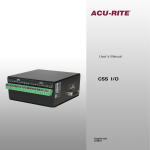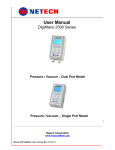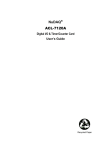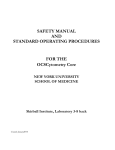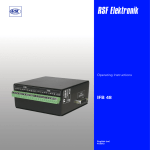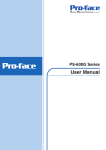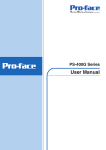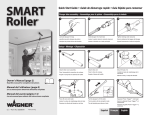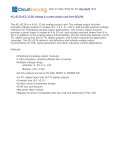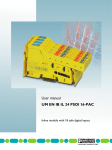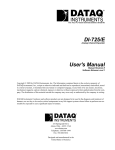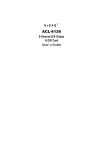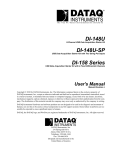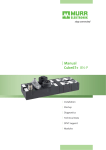Download Manual - DATAQ Instruments
Transcript
DI-400 Series User Manual Warranty and Service Policy Product Warranty Dataq Instruments, Inc. warrants that its hardware will be free from defects in materials and workmanship under normal use and service for a period of one year from the date of shipment. Dataq Instruments’ obligations under this warranty shall not arise until the defective material is shipped freight prepaid to Dataq Instruments. The only responsibility of Dataq Instruments under this warranty is to repair or replace, at its discretion and on a free of charge basis, the defective material. This warranty does not extend to products that have been repaired or altered by persons other than Dataq Instruments employees, or products that have been subjected to misuse, neglect, improper installation, or accident. Dataq Instruments shall have no liability for incidental or consequential damages of any kind arising out of the sale, installation, or use of its products. Service Policy 1. All products returned to Dataq Instruments for service, regardless of warranty status, must be on a freightprepaid basis. 2. Dataq Instruments will repair or replace any defective product within 5 days of its receipt. 3. For in-warranty repairs, Dataq Instruments will return repaired items to the buyer freight prepaid. Out of warranty repairs will be returned with freight prepaid and added to the service invoice. i DI-400 Series User Manual Table of Contents Warranty and Service Policy ......................................................................................................................................................i Product Warranty......................................................................................................................................................................i Service Policy............................................................................................................................................................................i Table of Contents......................................................................................................................................................................... iii 1. Introduction ................................................................................................................................................................................1 Features......................................................................................................................................................................................1 Analog Input.............................................................................................................................................................................2 Analog Output..........................................................................................................................................................................2 Digital Input and Output ........................................................................................................................................................2 Digital Signal Processor..........................................................................................................................................................2 2. Specifications ..............................................................................................................................................................................3 I/O Connector and Signal Connections ...............................................................................................................................3 Interface Characteristics .........................................................................................................................................................3 Analog Inputs...........................................................................................................................................................................3 Analog Outputs (DI-400 and DI-410 only).........................................................................................................................4 Digital Input/Output................................................................................................................................................................4 Timing Input/Output...............................................................................................................................................................4 Input List Architecture............................................................................................................................................................4 Output List Architecture.........................................................................................................................................................4 On-board DSP...........................................................................................................................................................................5 Physical/Environmental..........................................................................................................................................................5 Gain and Other Special Considerations for -PGL Models................................................................................................5 3. Getting Started...........................................................................................................................................................................7 Unpacking.................................................................................................................................................................................7 Configuring the DI-400 Series Board...................................................................................................................................7 Jumper Configuration .....................................................................................................................................................7 DIP Switch Configuration..............................................................................................................................................8 Installing the DI-400 Series Board......................................................................................................................................10 4. Accessories.................................................................................................................................................................................13 The DI-705: Signal Input/Output Option ..........................................................................................................................13 General.............................................................................................................................................................................13 Input Signal Configuration ..........................................................................................................................................13 The DI-75B: 5B Module Expander ....................................................................................................................................13 The DI-725: Analog Channel Expander............................................................................................................................13 CABL-4: Femal 37-pin “D” to 16 BNC Connectors.......................................................................................................14 CABL-5: Male to Female 37-pin “D”................................................................................................................................14 The DI-205: Signal Input/Output Panel.............................................................................................................................14 General.............................................................................................................................................................................14 DI-205 Input/Output Panel Interconnections............................................................................................................14 Input Signal Configuration ..........................................................................................................................................15 Connecting a Single-ended Amplifier................................................................................................................16 Connecting a Differential Amplifier...................................................................................................................16 Signal Cable and the Differential Amplifier .............................................................................................................18 Increasing the Total Analog Input Channel Capacity .....................................................................................................18 General.............................................................................................................................................................................18 The DI-5002 Bare Board..............................................................................................................................................19 The DI-5003 Bare Board..............................................................................................................................................20 DI-500 Series Expander Instruments..........................................................................................................................21 iii DI-400 Series User Manual Enabling Channels for Acquisition with WINDAQ Software .................................................................................22 5. Calibration ................................................................................................................................................................................23 Required Equipment .............................................................................................................................................................23 A/D Calibration......................................................................................................................................................................23 D/A Calibration......................................................................................................................................................................28 6. Block Diagram .........................................................................................................................................................................29 iv DI-400 Series User Manual 1. Introduction Congratulations on your purchase of a DI-400 Series data acquisition board. It permits data acquisition on IBM personal computers and compatibles from either Windows or the DOS programming environments. This manual describes how to install and use the DI-400 Series analog and digital I/O board. It is assumed that you have a general understanding of data acquisition, digital I/O, and DSP operations, and that you possess enough proficiency in software to write your own application and/or diagnostic programs (unless you will be using ready-torun WINDAQ software). Features The DI-400 Series board provides the following features: • Per channel software-configurable settings: Single-ended or differential input Input gain Sample rate Signal Averaging Channel expansion Input and output measurement range • Digital calibration of D/A converters • 250kHz (DI-400) or 125kHz (DI-410) burst sampling rate. Note that it is possible to operate the DI-400 and DI401 at a sample rate of 500kHz with some restrictions. Contact Dataq Instruments technical support for complete details. • Eight each digital input and output lines • A/D subsystem with up to 16 input channels provides 12-bit (DI-400 and DI-401) or 14-bit (DI-410) resolution. • 256-entry input list allows you to scan analog signals, digital signals, or a mixed combination of analog and digital signals for signal processing operations. Any sequence of input channels may be sampled at any available gain, with unique single-ended/differential configurations. The 256-entry input list also allows you to average consecutive readings for low-noise output signals. Additionally, the 256-entry input list also allows you to output digital data while simultaneously scanning analog input signals. • 256 counters are assigned to the input list allowing each channel to be programmed for a different sample rate. • D/A subsystem provides 12-bit (DI-400) or 14-bit (DI-410) resolution. • 16-entry output list allows you to write analog outputs, digital outputs, or a mixed combination of analog and digital outputs. • 16 output counters allow each analog or digital output to be written at its own sample rate. • Programmed I/O (PIO) data transfer modes • Simultaneous input and output (mixed analog or digital I/O) • Signal averaging of up to 65,536 consecutive readings per channel • Supports analog pre- and post-triggering of data acquisition based on the level and slope of a specified channel Introduction 1 DI-400 Series User Manual The following provides a brief overview of the major subsystems of DI-400 Series boards. Analog Input 16 single-ended or 8 differential analog inputs allow your analog signals to be converted into 12-bit (DI-400 and DI401) or 14-bit (DI-410) digital data via the onboard A/D converter. The board then transfers the digital data to user memory by PIO data transfer operations. The DI-400 Series boards feature an input range of ±10V (DI-400 and DI-410) or ±5V (DI-401). On DI-400 boards, the input gain is programmable. The DI-400-PGL has gains of 1, 10, and 100 to accommodate sampling of full-scale inputs to ±100mV while the DI-400-PGH has gains of 1, 2, 4, and 8 to accommodate sampling of full-scale inputs to ±1.25V. On DI-410 boards, the input gain is also programmable, but only with gains of 1, 2, 4, and 8 to accommodate sampling of full-scale inputs to ±1.25V. Analog Output The D/A subsystem on the DI-400 features two 12-bit D/A converters for outputting analog data. The D/A subsystem on the DI-410 features two 14-bit D/A converters for outputting analog data. An onboard 16-entry output counter list allows you to write analog or digital output at the maximum conversion rate of the board. Digital Input and Output DI-400 Series boards contain 8 each input and output lines for input/output operations. Digital inputs can monitor alarms or sensors with TTL outputs, while digital outputs can drive TTL inputs on control or measurement equipment. Digital Signal Processor DI-400 Series boards utilizes Analog Devices AD2181 DSP chip. Introduction 2 DI-400 Series User Manual 2. Specifications I/O Connector and Signal Connections All user connections are made to a single 37-pin D-shell connector as follows: LL GND or DAC2* 19 CH1 LO IN/CH9 HI IN 18 CH2 LO IN/CH10 HI IN 17 CH3 LO IN/CH11 HI IN 16 CH4 LO IN/CH12 HI IN 15 CH5 LO IN/CH13 HI IN 14 CH6 LO IN/CH14 HI IN 13 CH7 LO IN/CH15 HI IN 12 CH8 LO IN/CH16 HI IN DO5 DAC1 DO6 POWER GND DI1 DI3 DO1 DO3 DI5 +5V PWR 11 10 9 8 7 6 5 4 3 2 1 37 CH1 HI IN 36 CH2 HI IN 35 CH3 HI IN 34 CH4 HI IN 33 CH5 HI IN 32 CH6 HI IN 31 CH7 HI IN 30 CH8 HI IN 29 28 27 26 25 24 DI7 23 22 21 20 PSEUDO-DIFFERENTIAL or NORMAL INPUTS* DO7 DO4 DI0 DI2 DO0 DO2 DI6 DI4 *Depends on jumper position Interface Characteristics Compatible bus Expansion slot requirements Addressable locations Data path I/O address space Analog Inputs Number of input channels Analog resolution Sampling rate Relative accuracy Integral nonlinearity Differential nonlinearity Maximum analog measurement range Overvoltage protection 16-bit ISA or EISA one, half-length, 16-bit slot 100-3F016 16 bits 8 bytes 16 single-ended, 8 differential (DI-400 and DI-410) 16 single-ended (DI-401) 12-bit, 1 part in 4096 (DI-400 and DI-401) 14-bit, 1 part in 16,384 (DI-410) DI-401: 500,000 samples/sec with some restrictions. Call for details. DI-400: 250,000 samples/sec max, up to 500,000 with some restrictions. Call for details. DI-410: 125,000 samples/sec max 0.05% ±1 LSB max ±0.9 LSB max ±10V (DI-400 and DI-410) ±5V (DI-401) ±30V Specifications 3 DI-400 Series User Manual Common mode rejection ratio Input impedance Data Transfers Gain ranges (software selectable per channel) 80dB min @Av =1 1 MΩ minimum Programmed I/O 1, 2, 4, 8 or 1, 10, 100 (DI-400) 1, 2, 4, 8 (DI-410) 1 (fixed) (DI-401) Analog Outputs (DI-400 and DI-410 only) Two Number of channels Resolution 12-bit; 1 part in 4,096 (DI-400) 14-bit; 1 part in 16,384 (DI-410) Data transfers Programmed I/O Update rate 100,000 Hz Nonlinearity ±1 LSB max Differential nonlinearity ±0.9 LSB max Relative accuracy 0.05% Output voltage range ±10V Current drive capability ±5mA Output settling time to 0.01% 10µs Output impedance 0.3Ω Digital Input/Output Capacity Compatibility Max source current Max sink current Digital input termination 8 each input and output TTL compatible 0.4mA @ 2.4V 8mA @ 0.5V 4.7kΩ pull-up to +5VDC Timing Input/Output Number of input counters Number of output counters Resolution Base clock accuracy Counter input frequency 256 16 1 part in 32,768 0.01% 16 MHz Input List Architecture Positions 256 scan elements Element size 32-bits Element bit assignments: 16 bits Sample rate definition D0-D3: Channel number D4: Single-ended or differential D5-D6: Gain D7: Unipolar or bipolar D8-D12: Digital output bits (5) D13: Digital output bits on/off D14: Sample averaging on/off D15: Reserved Output List Architecture Positions 16 scan elements Element size 32-bits Element bit assignments: 16 bits Output rate definition D0: Specifies analog or digital output Specifications 4 DI-400 Series User Manual D1: D2-D7: D8-D15: Digital output bits on/off Don’t care Digital output data On-board DSP Type Clock frequency Data memory Program memory Physical/Environmental Board dimensions I/O connector Operating environment: Component temperature Relative humidity Storage environment: Temperature Relative humidity Analog Devices AD2181, 32 MIPS 16 MHz external, 64 MHz internal 16k words 16k words 8.5 in by 4.25 in 37-pin male D-type 0° to 70° C 5% to 90% non condensing -55° to 150° C 5% to 90% non condensing Gain and Other Special Considerations for -PGL Models The DI-400 is offered in two models: the DI-400-PGH and the DI-400-PGL. The -PGH model offers programmable gain factors of 1, 2, 4, and 8 for high level inputs (hence low level gains) while the -PGL model offers programmable gain factors of 1, 10, and 100 for low level inputs (hence high level gains). If you have a DI-400-PGL model instrument, you have the capability of applying relatively high gain factors. An undesirable characteristic that accompanies this capability is an industry-wide phenomenon known as cross talk. In a multiple channel system operating at high gain levels, cross talk is the tendency of information on one channel to bleed or leak to another channel. When acquiring multiple channels at high gain levels, the following guidelines should be observed to eliminate or minimize the effects of cross talk: 1. To greatly reduce cross talk, program each channel’s gain so there is no more than a 10X difference between all channels. For example, when acquiring two channels, programming gains of 1 and 10 or 10 and 100 will greatly reduce cross talk. Similarly, when acquiring three channels, gains of 1, 1, and 10, or 10, 10, and 100 will work as well. 2. If the above solution is not possible, cross talk can be minimized by channel segregation. This is accomplished by applying one gain factor to single-ended channels 0 through 7 and a different gain factor to channels 8 through 15. The cross talk specification for all -PGL models at a sample rate of 250kHz is less than -70db when both channel gains are less than 100. At a sample rate of 200kHz, crosstalk is less than -60db when one channel gain is equal to 100. Specifications 5 DI-400 Series User Manual 3. Getting Started Unpacking The following items are included with each DI-400 Series package. Verify that you have the following: • DI-400 Series board • The WinDaq Resource CD-ROM • DI-400 PGH/PGL, DI-401, and DI-410 User’s Manual (which you are currently reading) If an item is missing or damaged, call Dataq Instruments at (330) 668-1444. We will guide you through the appropriate steps for replacing missing or damaged items. Save the original packing material in the unlikely event that your board must, for any reason, be sent back to Dataq Instruments. Keep your DI-400 Series board in its protective anti-static bag until you are ready to install it. When you remove the board from the bag, hold it by the edges and do not touch the components. Configuring the DI-400 Series Board The DI-400 Series board has two jumpers that must be checked before the board is installed. The board also has a bank of DIP switches that must be configured before installation. Changing the configuration of these jumpers and switches (if need be) is much easier now before the board is installed in your computer. The locations of the switches and jumpers are indicated in FIGURE 1. Pin 19 configuration jumper 1 1 Pseudo-differential/normal inputs jumper Port address select switches FIGURE 1 DI-400 Series board jumper locations Jumper JP11 is used to configure the input channels for normal or pseudo-differential operation. Jumper JP13 configures pin 19 of the 37-pin I/O connector as analog ground or as DAC2. Jumper Configuration A jumper is a device used to configure a specific state, condition, or option. This is accomplished by installing the jumper over a pair of pins on the board, thus electronically connecting the two pins. The position of the jumper on the pins determine the state, condition or option. To remove the jumper, grasp it firmly between thumb and forefinger and gently pull straight up, off of the pins and away from the board. To install the jumper, place it over the two desired pins, making certain that the pins line up with the two holes in the jumper, and push the jumper down until it is firmly seated. Getting Started 7 DI-400 Series User Manual The position of jumper JP11 configures the DI-400 Series inputs to operate in normal mode (16 single-ended or 8 differential inputs) or pseudo-differential mode (16 differential inputs all tied to a common return). The pseudodifferential mode uses the amplifiers low inputs for the common return. All DI-400 Series boards are initially set for normal operation (pins 1 and 2 jumpered and pins 3 and 4 jumpered). To configure the DI-400 Series board for pseudo-differential inputs, completely remove one jumper and place the other jumper over pins 2 and 3. The configurations for JP11 are shown in FIGURE 2. JP11 JP11 pin 4 pin 3 pin 2 pin 1 pin 3 pin 2 1 1 Normal mode Pseudo-differential mode FIGURE 2 Jumper JP11 Configuration The position of jumper JP13 determines the configuration of pin 19 on the 37-pin I/O connector. When the jumper is installed on pins 1 and 2, pin 19 is DAC2. When the jumper is installed on pins 2 and 3, pin 19 is analog ground. The configurations for JP13 are shown in FIGURE 3. JP13 JP13 pin 3 pin 2 pin 1 pin 2 1 1 Pin 19 is DAC2 Pin 19 is analog ground FIGURE 3 Jumper JP13 Configuration DIP Switch Configuration The board also has a bank of seven DIP switches that are used to configure the I/O port (or base) address of the DI400 Series board. These switches select the I/O port (or base) address for the DI-400 Series board. All DI-400 Series boards are initially set for a port address of 180hex. In most instances, this port address is free (unused) and generally should work fine without reconfiguration. Unless you have an obvious conflict (another device in your computer is known to be using a port address of 180hex), do nothing. If you do have a port address conflict with another device, you will have to configure the DI-400 Series board for a port address other than 180hex. The port address is used by your computer to locate the board during operation. A port address for any device installed in your computer must be unique to that device. Any overlap of port address ranges between two or more boards will cause improper operation. DI-400 Series boards require 8 contiguous bytes of I/O space. Personal computers reserve 1024 bytes of memory (from 000hex to 3FFhex) for I/O devices. However, not all 1024 bytes of this I/O memory is available for the DI-400 Series board. This limits where you can place the DI-400 Series board in the I/O space. DI-400 Series boards can fit into any unoccupied 8-byte portion of I/O memory from 100hex to 3F0hex. The following table can be used as a guide for the selection of a port address suitable for the DI-400 Series board. It lists devices that normally occupy certain Getting Started 8 DI-400 Series User Manual port addresses. If your computer has a device installed that appears in the “Usually Used By:” column, then that port address should not be specified for the DI-400 Series board. Make sure that the DI-400 Series board’s port address is not set to an address already used by another device in your computer. Hex Range 170-177 1F0-1F7 200-207 238-23B 23C-23F 278-27F 2B0-2DF 2E0-2E7 2E8-2EF 2F8-2FF 300-31F 320-32F 360-36F 370-377 378-37F 380-38F 3A0-3AF 3B0-3BB 3BC-3BF 3C0-3CF 3D0-3DF 3E8-3EF 3F0-3F7 3F8-3FF Usually Used By: Fixed Disk Controller #2 Fixed Disk Controller #1 Game Port Bus Mouse Alt. Bus Mouse Parallel Printer Port EGA GPIB (AT) Serial Port Serial Port Prototype Card Hard Disk (XT) Reserved Floppy Controller #2 Parallel Printer Port SDLC SDLC MDA Parallel Printer Port VGA EGA CGA Serial Port Floppy Controller #1 Serial Port Your board’s I/O port address is set with the DIP switches. These switches, shown in FIGURE 4, represent bits 3 through 9 of the port address (bits 0 through 2 do not matter) and are used to turn an address line either on or off. You can configure the DI-400 Series board for an I/O port address from 100hex to 3F8hex in increments of 8. Once again, the default selection is 180hex and in most instances does not need to be changed. A switch setting is changed by flipping the switch. A switch in the ON position selects a 0 for the bit it represents. A switch in the OFF position selects a 1 for the bit it represents. Therefore, the value of an address line exists only when the switch is in the OFF position. FIGURE 4 Switch configuration; default port address 180 When you have decided on a port address and verified the absence of conflicts, configure switches 1 through 7. Remember this port address setting. You will need it when you install the software. Incidentally, the port address is defined as the lower number in the range. For example, a port address range of 350 - 357 is referred to as 350. Getting Started 9 DI-400 Series User Manual Installing the DI-400 Series Board After you have configured the jumpers and DIP switches (if needed), you are ready to install the DI-400 Series board in your computer. 1. Before you start, turn the power off on your computer. 2. Remove the computer's cover following the directions provided by your computer's manufacturer. 3. Locate your computer’s expansion slots. Choose a 16-bit expansion slot into which the DI-400 Series board will be inserted. Note that a 16-bit slot is one characterized by dual expansion slot connectors (see FIGURE 5). 4. Using a screwdriver, remove the slot cover directly behind the dual expansion slot chosen in step 3 by removing the screw at the top (refer to FIGURE 5). The slot cover is no longer needed and may be saved or discarded at your discretion. Save the screw. You will need it to secure the DI-400 Series board to the rear panel. Dual expansion slot FIGURE 5 Removing the slot cover from the computer's rear panel 5. Pick up the DI-400 Series board and, holding it carefully without touching the gold-plated connectors, position the board so that the Option Retaining Bracket (ORB) at the rear of the board slides into the area previously occupied by the slot cover (refer to FIGURE 6). Note that since the gold-plated card edge connectors are inserted into the dual expansion slot, it is impossible to orient the board incorrectly. Getting Started 10 DI-400 Series User Manual Option Retaining Bracket FIGURE 6 Installing the DI-400 Series card into the expansion slot 6. Position the DI-400 Series board over the chosen dual expansion slot. Put a thumb on the top edge of the board, rock it gently lengthwise to get it started, then press down firmly until the board is fully seated. 7. Install the screw laid aside in step 4 into the option retaining bracket to hold the board firmly in place. 8. Replace your computer's cover following the instructions provided by the manufacturer. This completes the board installation. The next step required before you actually start using the DI-400 Series board is to install the software. Two software options for DI-400 Series boards are WINDAQ software and the ActiveX Control Library, which supports LabVIEW, TestPoint, HP VEE, etc. The ActiveX Control Library is automatically installed with the installation of WinDaq Lite/Pro or Pro+. To begin the WinDaq software installation, insert The WinDaq Resource CD-ROM into your CD-ROM drive and select, “Install software for all other products except DI-194.” Getting Started 11 DI-400 Series User Manual 4. Accessories This section describes hardware products that may be used with DI-400 Series boards. Contact Dataq Instruments for information on the latest available accessories. The DI-705: Signal Input/Output Option General The DI-705 is a screw terminal signal interface that provides a convenient way to interface analog input and digital input/output signals to the DI-400. It plugs into the 37-pin “D” connector on the DI-400 and provides signal access through screw terminal strips. The terminal strips accept 16-22 gauge wire and each screw terminal is silk screened with the corresponding “D” connector pin number. The DI-705 also features a 37-pin male “pass-through” connector, which allows you to connect our BNC cable (model number CABL-4), or our DI-75B, or any 37-pin DAS-16 compatible cable to the DI-400 while still allowing screw terminal access. Input Signal Configuration “Pass through” connector. Signal connections are made to these screw terminals. Plugs directly into the DI-400 Any combination of single-ended or differential channels may be connected to the DI-705, but keep in mind a differential channel uses two analog inputs. Configure single-ended and differential channels on the DI-705 the same way as on the DI-400. Refer to the paragraph titled “I/O Connector and Signal Connections” in the Specifications section of this manual for single-ended/differential configuration details. The DI-75B: 5B Module Expander The DI-75B is an eight-channel expansion instrument that allows you to make isolated, industrial-type measurements with the DI-400. Each DI-75B measures 9”L × 7.29”W × 2.7”H and accepts up to eight DI-5B signal conditioning modules to bring thermocouple, true rms, voltage, strain, frequency, process current, RTD, potentiometer, and DC transducer measurement capability to the DI-400, in any combination suitable for your application. The DI-725: Analog Channel Expander The DI-725 is a 32-channel analog expansion device that allows you to increase the analog input channel capacity of the DI-400. Each DI-725 measures 9”L × 7.29”W × 1.52”H and features 32 differential analog inputs, dual programmable gain amplifiers with gain selections of 1, 2, 4, and 8; and a ±10 volt full scale measurement range (at Accessories 13 DI-400 Series User Manual a gain of 1). The DI-725 derives it’s power from the host DI-400 and in most cases will not require an additional power supply. CABL-4: Femal 37-pin “D” to 16 BNC Connectors CABL-4 is an interface cable that allows you to use the DI-400 with any device that uses BNC-style connectors. CABL-4 features a 37-pin female “D” connector on one end that mates directly with the DI-400 and 16 BNC connectors on the other, each individually labeled. CABL-5: Male to Female 37-pin “D” Instead of directly connecting the DI-705 to your DI-400 instrument, six-foot long CABL-5 can be used between them to allow more accessibility when connecting your input signals to the DI-705. The DI-205: Signal Input/Output Panel General The DI-205 is a termination panel for general purpose input and output. The DI-205 along with the supplied threefoot cable provides a convenient way to interface digital input/output, analog output, and analog input signals to DI400 Series boards. Signal connection is via terminal strip for digital and analog output signals, or 5-way binding posts (banana sockets) for analog input signals. DI-205 Input/Output Panel Interconnections DGND DI0 DI1 DI2 DI3 DI4 DI5 DI6 DI7 DO0 DO1 DO2 DO3 DO4 DO5 DO6 DO7 DAC1 DAC2 VOUT Digital I/O – Analog Output S. GND Dif. CHAN. 1 CHAN. 9(1) CHAN. 2 S. GND S. GND S. GND S. GND S. GND S. GND CHAN. 3 CHAN. 4 CHAN. 5 CHAN. 6 CHAN. 7 CHAN. 8 CHAN. 10(2) CHAN. 11(3) CHAN. 12(4) CHAN. 13(5) CHAN. 14(6) CHAN. 15(7) CHAN. 16(8) S. GND S. GND S. GND S. GND Model DI-205 Accessories 14 S. GND S. GND S. GND DI-400 Series User Manual Digital inputs Digital outputs Digital I/O – Analog Output DGND DI0 DI1 DI2 DI3 DI4 DI5 DI6 DI7 DO0 DO1 DO2 DO3 DO4 DO5 DO6 DO7 DAC1 DAC2 VOUT Analog outputs S. GND Dif. CHAN. 1 SGND CHAN. 2 S. GND S. GND S. GND S. GND S. GND S. GND Analog inputs CHAN. 3 CHAN. 4 CHAN. 5 CHAN. 6 CHAN. 7 CHAN. 8 CHAN. 9(1) CHAN. 10(2) CHAN. 11(3) CHAN. 12(4) CHAN. 13(5) CHAN. 14(6) CHAN. 15(7) CHAN. 16(8) S. GND S. GND S. GND S. GND S. GND S. GND S. GND Model DI-205 Digital Inputs (DI0 to DI7) The left end of the 20-connector screw terminal labeled “DGND” and “DI0” through “DI7” indicate the digital input ports of the DI-205. Digital Outputs (DO0 to DO7) The 8 digital output lines labeled “DO0” through “DO7” indicate the digital output ports of the DI-205. Analog Output (DAC1, DAC2, VOUT) The digital to analog converter (DAC) outputs have two applications: As a general purpose analog output accessible through W INDAQ or Programmer’s SDK software or as a variable signal suppression voltage automatically enabled and multiplexed to all channels through Programmer’s SDK software. Input Signal Configuration The DI-205 may be configured to connect to 16 single-ended or 8 differential channels. In addition, any combination of single-ended or differential channels may be applied. A differential channel is configured by using two singleended inputs according to the following illustration: S. GND S. GND Signal leads + input CHAN. 1 Signal leads CHAN. 1 - input CHAN. 9(1) CHAN. 9(1) S. GND S. GND Channel 1 configured for a single-ended input Accessories 15 Channel 1 configured for a differential input DI-400 Series User Manual Note that when an input channel is configured for differential operation, the binding post associated with that channel's high (+) input assumes the channel number. Connecting a Single-ended Amplifier A single-ended amplifier is the most straight forward approach to connecting signals to the DI-205. However, to derive adequate performance, the use of a single-ended amplifier requires that the signal to be measured is relatively high level (i.e. ≥1v full scale), and the distance from the signal source to the DI-205 is relatively short (≤15 feet). Assuming these conditions exist, a single-ended amplifier may be connected to your signal source as follows: Connecting a Differential Amplifier A differential channel configuration is a special case approach to signal measurement that should be used with all low-level measurements (i.e., when an input signal <1v) or when the signal to be measured is located far away from the DI-205 (i.e., >15 feet). When in a differential operating mode, the DI-205 amplifier sees the difference in voltage between the high (+) and low (-) inputs. Differential amplifiers have the advantage of reducing common mode voltages (i.e., those appearing simultaneously and in phase on both inputs). This capability may be leveraged to great advantage to reduce noise riding on a signal of interest. Two signal measurement conditions govern your configuration of a differential channel input: The signal to be measured is ground-referenced; or the signal to be measured is isolated from ground. Ground-referenced Signal Sources — A ground-referenced signal source is one with a local ground that may not be (and probably is not) at the same potential as the computer's ground. This potential difference between signal ground and computer ground is referred to as a common mode voltage and is caused by a number of different factors. Accessories 16 DI-400 Series User Manual The most common of these is different physical locations of the computer and signal ground points. Since wire is not a perfect conductor (i.e. exhibiting zero resistance regardless of length) a voltage drop, however small, will always be present. The differential amplifier is unique in its ability to measure signals originating from sources with different ground potentials relative to the computer providing it is connected properly. The most common error made in connecting differential amplifiers is the tendency to ground both ends of a signal shield. This causes current to flow through the shield and induces noise on the signal to be measured. This problem is eliminated by ensuring that only one ground exists on the signal circuit. Isolated Signal Sources — There are two considerations when connecting a differential amplifier to an isolated signal source: The elimination of ground loops as described above, and the use of bias resistors to provide bias current for the differential amplifier's positive and negative inputs. The bias resistors should be chosen to be as low as possible, but the value you use is dependent upon the output impedance of your signal source. Generally, the value of the bias resistor should be 10 times the output impedance of your signal source or higher. Bias resistors greater than 1MΩ are not recommended. Accessories 17 DI-400 Series User Manual Signal Cable and the Differential Amplifier A quick rule-of-thumb: Any application requiring a differential amplifier also defines a need for quality signal cable. Four elements combine to ensure adequate quality signal cable: a twisted signal pair with low resistance stranded copper conductors; surrounded by a multiple-folded foil shield; with a copper stranded drain wire; all contained within an insulated outer jacket. In applications where such signal cable is used, a dramatic decrease in noise pickup will be experienced. The drain wire should be considered as the shield and should be connected as described in the Connecting a Differential Amplifier section above. Signal cable meeting all four criteria for quality is Belden No. 8641. Increasing the Total Analog Input Channel Capacity General Any one of several instruments can be connected to the DI-400 Series board to increase its total input channel capacity. These instruments are as follows: Accessories 18 DI-400 Series User Manual “Bare Board” Instruments DI-5002, DI-5003 DI-500 Series Expander Instruments DI-500-32-DX DI-500-32-PX DI-510-32-DX DI-510-32-PX DI-510-64-DX DI-510-64-PX The DI-5002 is simply a bare board that provides economical, high-level input channel expansion capability for DI400 Series boards. The DI-5003 is also an economical bare board, but it provides signal conditioned input channel capability (via DI-5B signal conditioning modules) for DI-400 Series boards. The DI-5002 and DI-5003 can be used by themselves or together, in various configurations, to get the desired mix of high-level and/or signal conditioned channels. The DI-500 Series Expander instruments provide all means of channel expansion capability for DI-400 Series instruments. They are a complete solution and feature a more finished appearance with portable, desktop, or rackmount enclosures and labeled overlays. The DI-5002 Bare Board To increase high-level input channel capacity with the DI-5002, simply connect the appropriate end of the included expansion cable to the DI-400 Series board and connect the other end of the cable to the 40-pin IDC connector labeled “IN” on the DI-5002 board (refer to the following illustration). Note that the connector on the DI-5002 board is “keyed”, therefore difficult to improperly connect. Power for the DI-5002 is derived from the DI-400 Series board, through the expansion cable. The 40-pin IDC connector labeled “OUT” on the DI-5002 board can be used to further increase channel capacity. Several instruments can be “daisy chained” together by connecting additional expansion cables from the OUT connector of the DI-5002 board currently in use to the IN connector of another DI-5002 board. All channel connections are now made at the DI-5002 instead of the DI-400 Series board. Refer to the following illustration for channel assignments. Accessories 19 DI-400 Series User Manual The DI-5003 Bare Board To add signal-conditioned input channel capability to your DI-400 Series board, simply connect the appropriate end of CABL-1 (expansion cable) to the DI-400 Series board and connect the other end of the cable to the 26-pin IDC connector on the DI-5003 board (refer to the following illustration). Note that the connectors on the DI-5003 board are “keyed”, therefore difficult to improperly connect. The DI-5003 can be powered either from a 5VDC or a 9 to 36VDC source. Each DI-5003 board provides 16 signal-conditioned input channels. If you want to add more than 16 channels of signal conditioned input capability to your DI-400 Series instrument, you must include a DI-5002 with each additional DI-5003 board. All signal conditioned input channel connections are now made at the DI-5003. Refer to the following illustration for channel assignments. Accessories 20 DI-400 Series User Manual DI-500 Series Expander Instruments To increase channel capacity with any of the DI-500 Series expander instruments, simply connect the appropriate end of the included expansion cable to the DI-400 Series board and connect the other end of the cable to the 37-pin connector labeled EXPANSION IN on the DI-500 Series instrument overlay (refer to the following illustration). Power for the DI-500 Series expander instrument is derived from the DI-400 Series board, through the expansion cable (ignore the POWER INPUT jack and the POWER switch on the DI-500 Series expander instrument. They are nonfunctional when used with the DI-400 Series). All channel connections are now made at the DI-500 Series expander instrument instead of the DI-400 Series board. Accessories 21 DI-400 Series User Manual Enabling Channels for Acquisition with WINDAQ Software W INDAQ recording software features a channel selection grid for enabling or configuring channels for acquisition. A typical grid looks similar to this: The grid is displayed in W INDAQ/Pro or W INDAQ/Pro+ by pointing to the Edit menu and dragging down to Channels… Each box in this grid represents an input channel. An input channel is enabled by clicking the desired box. Where in the grid you click, which mouse button you click with, and how many times you click the mouse button determines whether the input channel is enabled for differential operation, for operation defined by the DI-5B module (if used), or for differential operation between a pair of channels (refer to Appendix E of the W INDAQ/Pro and W INDAQ/Pro+ User’s Manual for complete details). Accessories 22 DI-400 Series User Manual 5. Calibration This section provides calibration procedures for the A/D and D/A subsystems of DI-400 Series boards. Required Equipment A/D Calibration • A precision DVM with resolution as a function of the A/D gain range being calibrated. Consult the following chart for the minimum resolution required of your DVM at the indicated gain: A/D Gain 1 2 4 8 10 100 • Minimum DVM Resolution 2.44mV 1.22mV 0.61mV 0.305mV 0.244mV 24.41µV A stable voltage source with a stability specification equal to or greater than the resolution shown above at the highest gain to be calibrated. OR • An alternative is to use a voltage calibrator with resolution as shown above at the highest gain to be calibrated. D/A Calibration • A precision DVM with resolution of at least 1 mv. A/D Calibration Calibration of the board’s A/D subsystem is performed with the following connections: Precision DVM - Stable Voltage Source + I/O Connector Pin #: 37 • + 36 • 35 Analog Common 28 Make sure jumper JP11 (on the DI-400 Series board) is configured for normal mode: pin 4 Normal mode has pins 1 & 2 jumpered and pins 3 & 4 jumpered. pin 3 pin 2 pin 1 JP11 Or if you are using the alternative voltage calibrator, the following figure illustrates the necessary connections: Calibration 23 DI-400 Series User Manual Voltage Calibrator I/O Connector Pin #: 37 + 36 - 35 Analog Common 28 Make sure jumper JP11 (on the DI-400 Series board) is configured for normal mode: pin 4 Normal mode has pins 1 & 2 jumpered and pins 3 & 4 jumpered. pin 3 pin 2 pin 1 JP11 When either of the above circuits are connected, run W INDAQ/Pro or WINDAQ/Pro+ recording software and follow these steps: 1. In WINDAQ/Pro or WINDAQ/Pro+, enable channels 1, 2, and 3 (i.e., point to the Edit menu and drag down to Channels…, etc. Complete channel enabling details can be found in the WINDAQ/Pro and WINDAQ/Pro+ User’s Manual). Also select a screen format that enables you to see all three channels onscreen at the same time. 2. Set the burst rate to 50,000 Hz as follows: 3. a. Point to the Edit menu, drag down to Preferences, and release the left mouse button. This displays the Edit Preferences submenu. b. In the Edit Preferences submenu, click Maximum Sample Rate… This displays the ma ximum sample rate dialog box: c. Enter 50000 in the text box and close the dialog box by clicking the OK button. Set the sample rate to 50 as follows: a. Point to the Edit menu and drag down to Sample Rate… This displays the sample rate dialog box: Calibration 24 DI-400 Series User Manual b. 4. Enter 50 in the text box and close the dialog box by clicking the OK button. Select channel 1 (if not already selected): When selected, a box surrounds the variable waveform assignment indicator, indicating that the channel is selected for adjustment. 5. Select the average acquisition mode and set the gain for each channel as follows: a. Point to the Edit menu and drag down to Channel Settings… This displays the “Channel 1 Settings” dialog box. b. Click the Average button in the Acquisition Method section of the dialog box. Click here to select the average mode. c. Click on the gain factor 1 in the top left corner of this dialog box to set channel 1’s gain to 1. d. Click the Next button at the bottom of the dialog box to display the “Channel 2 Settings” dialog box. Calibration 25 DI-400 Series User Manual e. Repeat steps b and c for channel 2. f. Click the Next button at the bottom of the dialog box to display the “Channel 3 Settings” dialog box. g. Repeat only step b for channel 3. h. Now click on the gain factor 8 (if you have a –PGH model instrument) or 100 (if you have a – PGL model instrument) in the top left corner of this dialog box to set channel 3’s gain to the highest possible setting. i. Click the OK button to close the “Channel 3 Settings” dialog box. 6. Select channel 1 again if not already selected (refer to step 4 if you do not remember how to select a channel for adjustments). 7. Set the instruments A/D converter to it’s full dynamic range on channel 1 as follows: a. With channel 1 selected, point to the Scaling menu and drag down to Show Dynamic Range. 8. Repeat steps 6 and 7 for channels 2 and 3. 9. Adjust the ADC Offset pot until WINDAQ software’s channel 2 numerical display reads zero volts (refer to the illustration at the end of this procedure for pot locations and descriptions). Calibration 26 DI-400 Series User Manual Adjust ADC Offset until this reads zero volts. 10. Adjust the PGA Offset pot until WINDAQ software’s channel 3 numerical display reads zero volts (or as close as possible, since this pot is a much finer adjustment than in the previous step). This adjustment causes the ADC Offset (adjusted in the previous step) to increase slightly. This is normal, it is a back-and-forth, give-and-take type of adjustment. Adjust PGA Offset until this reads zero volts. Calibration 27 DI-400 Series User Manual 11. Repeat steps 9 and 10 until both channel’s numerical display reads zero volts (or as close as possible). 12. Using the voltage source, apply a voltage that is as close as you can get to the full scale input range of your DI400 Series instrument without exceeding it. For example, apply 9.5V (you can use a fresh 9 volt battery) for a DI-400 or DI-410, or 4.5V for a DI-401. 13. Adjust the Span ADC pot until WINDAQ software’s channel 1 numerical display reads the same as the DVM. ADC Offset Span ADC PGA Offset D/A Calibration The D/A subsystem of your DI-400 Series instrument is calibrated before it leaves our facility and in normal use, should never need to be re-calibrated. Contact Dataq Instruments technical support if you have reason to suspect you need D/A calibration. Calibration 28 DI-400 Series User Manual 6. Block Diagram DI-400 and DI-410 Block Diagram Block Diagram 29 DI-400 Series User Manual DI-401 Block Diagram ADC 16Mhz Analog in Dig out port Digital out Dig in port Digital in Mux Timer DSP Program RAM 16K Words +15V Data RAM 16K Words EE Prom -15V DC/DC Converter Bus interface ISA Bus Block Diagram 30 DATAQ Instruments, Inc. 241 Springside Drive Akron, Ohio 44333 Telephone: 330-668-1444 Fax: 330-666-5434 E-mail: [email protected] Direct Product Links (click on text to jump to page) Data Acquisition | Data Logger | Chart Recorder | Thermocouple | Oscilloscope




































